Here is the deal; know who you are playing with before you play any super big, wide sounding chords. If you put a bunch of hair on your chords, the guy you're playing behind might get mad if he don't like big hairy chords. I heard Miles Davis and Monk used to fight about this. When you put a bunch of extensions on your chords you are pretty much dictating what scale the soloist has to play. For example, a dominant chord with, let's say, a #9 and a #5 on the top comes only from the altered scale - the soloist is pretty much stuck with the altered scale as choice to improvise with.
Let's start with the most basic ii - V - I you can play. The following ii - V - I chord progression contains only the 3rds and 7ths of the chords. Voice leading is sheer perfection; the minor seventh of the Dmin7 chord gets lowered to the major 3rd of the G7 chord, while the minor third of the same Dmin7 chord stays where it is and becomes the minor seventh of the G7 chord. What happens to the two notes in the G7 chord when it changes to the Cmaj7 chord? These chord voicing are safe. Nobody will ever get mad at you if you play chords like these.

The next two examples are of slightly more harmonically complex voicings (They got some hair on 'em). The V chords in both examples come from the G altered scale (Ab melodic minor). If the altered scale is the scale that the guy your playing behind likes to use on V chords, you guys will get along fine. Again, check what the separate voices in the chords are doing. Are they all moving in the same direction? Are some moving while others are staying put as common tones?
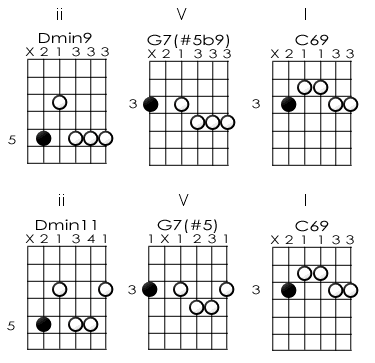
The next example demonstrates how you can keep things simple by concentrating on the middle strings. I would suggest that while playing with a bassist, don't play any roots. I included the roots for reference but almost never play them myself. As the F7#5 chord comes from either the altered scale or the whole tone scale, the soloist has the choice of either to use. Notice in the first two chords how the notes on the fourth and third string slide down a half step while the note on the second string stays where it is. When the F7#5 chord changes to the Bb maj7#11 chord, the notes on both the third and second strings move up a half step while the note on the fourth string stays put. Without playing the roots, play the three chords and check out how the seperate notes move around in different directions while others stay the same.
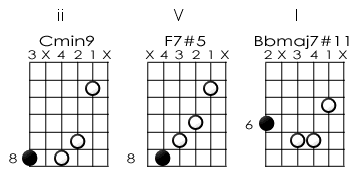
The next example is similar to the previous one except I included notes on the first string. Keep in mind, in this example, the dominant chord contains both the #5 and #9 meaning the only scale choice in the F altered scale (Gb melodic minor). Again, leave off the notes on the sixth and fifth strings when playing with a bassist.

Another example of the dominant chord from the altered scale. The voicing for the Bbmin11 chord is worth the stretch. Avoid the roots for these chords when playing in an ensemble situation. If you have to play the roots, you'll have to use your thumb on the first two. The root on the Ab chord is on the fourth string so it is probably safe to leave in when playing with a bassist because it is in a high enough register.
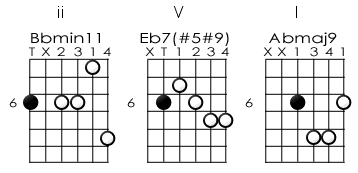
The next example demontrates how the dominant chord from the diminished dominant scale works. Notice how the G triad on the top three strings of the Emin11 chord moves down a half step to a F# triad in the A13b9 chord.
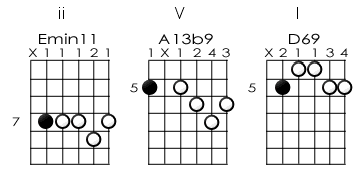
Last of all I included an example of some open string chord voicings. These work best in ballads. I first used this one in Herbie Hancock's "Dolphin Dance". As in the example before, the dominant chord comes from the diminished dominant scale.
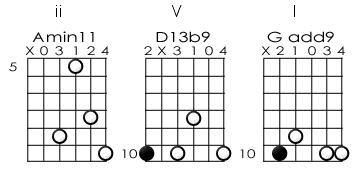
New Yorker Chris Juergensen is long time studio musician and session guitarist currently living and teaching in Japan.
His latest project is "Big Bad Sun", a CD traditional in nature, and contemporary in sound.